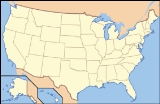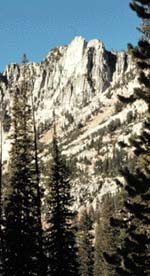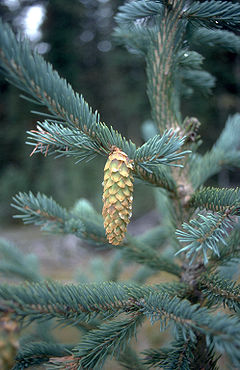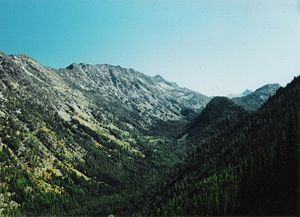
Eagle Cap Wilderness
Encyclopedia

Wallowa Mountains
The Wallowa Mountains are a mountain range located in the Columbia Plateau of northeastern Oregon in the United States. The range runs approximately 40 mi northwest to southeast in southwestern Wallowa County between the Blue Mountains to the west and the Snake River to the east. The range is...
of northeastern Oregon
Oregon
Oregon is a state in the Pacific Northwest region of the United States. It is located on the Pacific coast, with Washington to the north, California to the south, Nevada on the southeast and Idaho to the east. The Columbia and Snake rivers delineate much of Oregon's northern and eastern...
(United States
United States
The United States of America is a federal constitutional republic comprising fifty states and a federal district...
), within the Wallowa–Whitman National Forest. The Wilderness was established in 1940. In 1964, it was included in the National Wilderness Preservation System
National Wilderness Preservation System
The National Wilderness Preservation System of the United States protects federally managed land areas designated for preservation in their natural condition. It was established by the Wilderness Act upon the signature of President Lyndon B. Johnson on September 3, 1964...
. A boundary revision in 1972 added 73000 acres (29,542.1 ha) and the Wilderness Act of 1984 added 66100 acres (26,749.7 ha) resulting in a current total of 361446 acre (146,272 ha; 565 sq mi), making Eagle Cap by far Oregon's largest wilderness area.
Eagle Cap Wilderness is named after a peak in the Wallowa Mountains, which were once called the Eagle Mountains. At 9595 feet (2,924.6 m) Eagle Cap was incorrectly thought to be the highest peak in the range, hence the name.
Topography
The Eagle Cap Wilderness is characterized by high alpine lakes and meadows, bare granite peaks and ridges, and U-shaped glacial valleys. Thick timber is found in the lower valleys and scattered alpine timber on the upper slopes. Elevations in the Wilderness range from approximately 3000 feet (914 m) in lower valleys to 9845 feet (3,001 m) at the summit of Sacajawea Peak with 30 other summits exceeding 8000 feet (2,438.4 m). The Wilderness is home to Legore LakeLegore Lake
LeGore Lake is a tarn located in the Eagle Cap Wilderness of northeastern Oregon, United States. It is the highest true lake in Oregon at elevation. It is positioned near Twin Peaks and is accessed by a 4 mile hiking trail that ascends 4,000 feet and passes the LeGore mine, the lake's namesake....
, the highest lake above sea level in Oregon at 8950 feet (2,728 m), as well as almost 60 alpine lakes (9 of which are above 8,000 feet), and more than 37 miles (60 km) of streams.
History
The Eagle Cap Wilderness and surrounding country in the Wallowa–Whitman National Forest was first occupied by the ancestors of the Nez Perce Indian tribe around 1400 A.D., and later by the CayuseCayuse
The Cayuse are a Native American tribe in the state of Oregon in the United States. The Cayuse tribe shares a reservation in northeastern Oregon with the Umatilla and the Walla Walla tribes as part of the Confederated Tribes of the Umatilla Indian Reservation...
, the Shoshone
Shoshone
The Shoshone or Shoshoni are a Native American tribe in the United States with three large divisions: the Northern, the Western and the Eastern....
, and Bannocks
Bannock (tribe)
The Bannock tribe of the Northern Paiute are an indigenous people of the Great Basin. Their traditional lands include southeastern Oregon, southeastern Idaho, western Wyoming, and southwestern Montana...
. The Wilderness was used as hunting grounds for bighorn sheep
Bighorn Sheep
The bighorn sheep is a species of sheep in North America named for its large horns. These horns can weigh up to , while the sheep themselves weigh up to . Recent genetic testing indicates that there are three distinct subspecies of Ovis canadensis, one of which is endangered: Ovis canadensis sierrae...
and deer
Deer
Deer are the ruminant mammals forming the family Cervidae. Species in the Cervidae family include white-tailed deer, elk, moose, red deer, reindeer, fallow deer, roe deer and chital. Male deer of all species and female reindeer grow and shed new antlers each year...
and to gather huckleberries. It was the summer home to the Joseph Band
Chief Joseph
Hin-mah-too-yah-lat-kekt, popularly known as Chief Joseph, or Young Joseph was the leader of the Wal-lam-wat-kain band of Nez Perce during General Oliver O. Howard's attempt to forcibly remove his band and the other "non-treaty" Nez Perce to a reservation in Idaho...
of the Nez Perce tribe. 1860 marked the year the first settlers moved into the Wallowa Valley. In 1930, the Eagle Cap was established as a primitive area and in 1940 earned wilderness designation.
Wildlife

American black bear
The American black bear is a medium-sized bear native to North America. It is the continent's smallest and most common bear species. Black bears are omnivores, with their diets varying greatly depending on season and location. They typically live in largely forested areas, but do leave forests in...
, cougars
Cougars
Cougars is a Chicago-based rock band signed to the New York-based label Go-Kart Records.The Cougars' music is often compared to that of Rocket from the Crypt...
, Rocky Mountain bighorn sheep, and mountain goats. In the summer white-tailed deer
White-tailed Deer
The white-tailed deer , also known as the Virginia deer or simply as the whitetail, is a medium-sized deer native to the United States , Canada, Mexico, Central America, and South America as far south as Peru...
, mule deer
Mule Deer
The mule deer is a deer indigenous to western North America. The Mule Deer gets its name from its large mule-like ears. There are believed to be several subspecies, including the black-tailed deer...
, and Rocky Mountain elk
Rocky Mountain Elk
The Rocky Mountain Elk is a subspecies of elk found in the Rocky Mountains and adjacent ranges of Western North America. The winter ranges are most common in open forests and floodplain marshes in the lower elevations. In the summer it migrates to the subalpine forests and alpine basins...
roam the Wilderness. Smaller mammals that inhabit the area year-round include the pika
Pika
The pika is a small mammal, with short limbs, rounded ears, and short tail. The name pika is used for any member of the Ochotonidae, a family within the order of lagomorphs, which also includes the Leporidae . One genus, Ochotona, is recognised within the family, and it includes 30 species...
, pine martens
American Marten
The American marten is a North American member of the family Mustelidae, sometimes referred to as the pine marten. The name "pine marten" is derived from the common but distinct Eurasian species of Martes...
, badger
Badger
Badgers are short-legged omnivores in the weasel family, Mustelidae. There are nine species of badger, in three subfamilies : Melinae , Mellivorinae , and Taxideinae...
s, squirrel
Squirrel
Squirrels belong to a large family of small or medium-sized rodents called the Sciuridae. The family includes tree squirrels, ground squirrels, chipmunks, marmots , flying squirrels, and prairie dogs. Squirrels are indigenous to the Americas, Eurasia, and Africa and have been introduced to Australia...
s, and marmot
Marmot
The marmots are a genus, Marmota, of squirrels. There are 14 species in this genus.Marmots are generally large ground squirrels. Those most often referred to as marmots tend to live in mountainous areas such as the Alps, northern Apennines, Eurasian steppes, Carpathians, Tatras, and Pyrenees in...
s. Birds include peregrine falcon
Peregrine Falcon
The Peregrine Falcon , also known as the Peregrine, and historically as the Duck Hawk in North America, is a widespread bird of prey in the family Falconidae. A large, crow-sized falcon, it has a blue-gray back, barred white underparts, and a black head and "moustache"...
s, bald eagle
Bald Eagle
The Bald Eagle is a bird of prey found in North America. It is the national bird and symbol of the United States of America. This sea eagle has two known sub-species and forms a species pair with the White-tailed Eagle...
s, golden eagle
Golden Eagle
The Golden Eagle is one of the best known birds of prey in the Northern Hemisphere. Like all eagles, it belongs to the family Accipitridae. Once widespread across the Holarctic, it has disappeared from many of the more heavily populated areas...
s, Ferruginous hawk
Ferruginous Hawk
The Ferruginous Hawk , Buteo regalis , is a large bird of prey. It is not a true hawk like sparrowhawks or goshawks, but rather belongs to the broad-winged buteo hawks, known as "buzzards" in Europe...
s, and gray-crowned rosy finch
Gray-crowned Rosy Finch
The Gray-crowned Rosy Finch, or Gray-crowned Rosy-finch, is a species of passerine bird in the family Fringillidae native to Alaska, western Canada, and the north-western United States. Due to its remote and rocky alpine habitat it is rarely seen. There are currently six recognized subspecies...
. Trout
Trout
Trout is the name for a number of species of freshwater and saltwater fish belonging to the Salmoninae subfamily of the family Salmonidae. Salmon belong to the same family as trout. Most salmon species spend almost all their lives in salt water...
can be found in many of the lakes and streams in the Wilderness.
Vegetation
Plant communities in the Eagle Cap Wilderness range from low elevation grasslands and ponderosa pinePonderosa Pine
Pinus ponderosa, commonly known as the Ponderosa Pine, Bull Pine, Blackjack Pine, or Western Yellow Pine, is a widespread and variable pine native to western North America. It was first described by David Douglas in 1826, from eastern Washington near present-day Spokane...
forest to alpine meadows. Engelmann spruce
Engelmann Spruce
Picea engelmannii is a species of spruce native to western North America, from central British Columbia and southwest Alberta, southwest to northern California and southeast to Arizona and New Mexico; there are also two isolated populations in northern Mexico...
, larch
Larch
Larches are conifers in the genus Larix, in the family Pinaceae. Growing from 15 to 50m tall, they are native to much of the cooler temperate northern hemisphere, on lowlands in the north and high on mountains further south...
, mountain hemlock
Mountain Hemlock
Tsuga mertensiana, known as Mountain Hemlock, is a species of hemlock native to the west coast of North America, with its northwestern limit on the Kenai Peninsula, Alaska, and its southeastern limit in northern Tulare County, California....
, sub-alpine fir, and whitebark pine
Whitebark Pine
Pinus albicaulis, known commonly as Whitebark Pine, Pitch Pine, Scrub Pine, and Creeping Pine occurs in the mountains of the Western United States and Canada, specifically the subalpine areas of the Sierra Nevada, the Cascade Range, the Pacific Coast Ranges, and the northern Rocky Mountains –...
can be found in the higher elevations. Varieties of Indian paintbrush
Indian Paintbrush
Indian Paintbrush most often refers to:* Castilleja spp.Indian Paintbrush may also refer to:* Butterfly weed* Hawkweed* Steven Rales' production company, whose productions include The Darjeeling Limited, Towelhead and Fantastic Mr. Fox...
, sego lilies, elephanthead
Pedicularis groenlandica
Pedicularis groenlandica is a showy flowering plant in the Scrophulariaceae which is known by the common names elephant's head and elephanthead lousewort. This erect plant can grow to a height of 80 centimeters. Its sharply-toothed fernlike leaves are located low on the stout stem. The stem is...
, larkspur
Delphinium
Delphinium is a genus of about 300 species of perennial flowering plants in the buttercup family Ranunculaceae, native throughout the Northern Hemisphere and also on the high mountains of tropical Africa. The common name, larkspur, is shared with the closely related genus Consolida...
, shooting star
Dodecatheon
Dodecatheon is a genus of herbaceous flowering plants in the Primrose family Primulaceae. The species have basal clumps of leaves and nodding flowers that are produced at the top of tall stems that rise from where the leaves join the crown. They are commonly called Shooting Stars because of the...
, and bluebells are abundant in the meadows. The Wilderness does contain some small groves of old growth forest.
Recreation
As Oregon's largest Wilderness area, Eagle Cap offers many recreational activities, including hiking, backpacking, horseback riding, hunting, fishing, camping, and wildlife watching. Winter brings backcountry skiing and snowshoeing opportunities. There are 47 trailheads and approximately 534 miles (859.4 km) of trails in Eagle Cap, accessible from WallowaWallowa County, Oregon
Wallowa County is a county located in the U.S. state of Oregon. It is included in the 8 county definition of Eastern Oregon. According to Oregon Geographic Names, the origins of the county's name are uncertain, with the most likely explanation being that it is derived from the Nez Perce term for a...
, Union
Union County, Oregon
Union County is a county located in the U.S. state of Oregon. It is included in the 8 county definition of Eastern Oregon. The county is named for the town of Union, which is located within its boundaries; in 2010, the county population was 25,748. The county seat is La Grande.-History:Union County...
, and Baker
Baker County, Oregon
Baker County is a county located in the U.S. state of Oregon. It is included in the 8 county definition of Eastern Oregon. It is named for Edward Dickinson Baker, a senator from Oregon who was killed at Ball's Bluff, a battle of the Civil War in Virginia in 1861. It was split from the eastern part...
Counties, and leading to all areas of the Wilderness.
Wild and Scenic Rivers
Four designated Wild and ScenicNational Wild and Scenic River
National Wild and Scenic River is a designation for certain protected areas in the United States.The National Wild and Scenic Rivers Act was an outgrowth of the recommendations of a Presidential commission, the Outdoor Recreation Resources Review Commission...
rivers originate in Eagle Cap Wilderness - the Lostine
Lostine River
The Lostine River is a tributary of the Wallowa River in northeastern Oregon in the United States.It drains a portion of the Eagle Cap Wilderness of the Wallowa Mountains in the Wallowa-Whitman National Forest. It joins the Wallowa River at Wallowa...
, Eagle Creek
Eagle Creek (Oregon)
Eagle Creek may refer to any of a number of places in the U.S. state of Oregon:...
, Minam
Minam River
The Minam River is a tributary of the Wallowa River, long, in northeastern Oregon in the United States. It drains a rugged wilderness area of the Wallowa Mountains west of La Grande....
, and Imnaha
Imnaha River
The Imnaha River is a tributary of the Snake River in the U.S. state of Oregon. Flowing generally east near the headwaters and then north through Wallowa County, the entire river is designated Wild and Scenic...
.
Lostine River

Eagle Creek
27 miles (43.5 km) of Eagle Creek from its output at Eagle Lake in the Wilderness to the Wallowa–Whitman National Forest boundary at Skull Creek are designated Wild and Scenic. In 1988, 4 miles (6 km) of the river were designated "wild," 6 miles (10 km) are designated "scenic," and 17 miles (27.4 km) are designated "recreational."Minam
39 miles (62.8 km) of the Minam River from its headwaters at the south end of Minam Lake to the Wilderness boundary, one-half mile downstream from Cougar Creek, are designated Wild and Scenic. In 1988, all 39 miles (62.8 km) were designated "wild."Imnaha
77 miles (123.9 km) of the Imnaha River from its headwaters are designated Wild and Scenic. The designation comprises the main stem from the confluence of the North and South Forks of the Imnaha River to its mouth, and the South Fork from its headwaters to the confluence with the main stem. In 1988, 15 miles (24.1 km) miles were designated "wild," 4 miles (6 km) were designated "scenic," and 58 miles (93.3 km) were designated "recreational," though only a portion of the Wild and Scenic Imnaha is located within Eagle Cap Wilderness.Lakes
| Name | Elevation |
|---|---|
| Aneroid Lake Aneroid Lake Aneroid Lake is a large tarn located on Aneroid Mountain in the Eagle Cap Wilderness of Northeastern Oregon. It is situated in between Roger Lake and Dollar Lake. It is not accessible by any kind of motor vehicle. However, there is a popular hiking trail that leads to the lake. There is a small... |
7500 ft (2,286 m) |
| Bear Lake | 7905 ft (2,409.4 m) |
| Billy Jones Lake Billy Jones Lake Billy Jones Lake is a tarn located on Hurricane Divide in the Eagle Cap Wilderness of Northeastern Oregon, United States. It is situated less than one mile from Echo Lake. It is the second highest lake in the Eagle Cap Wilderness at , though some claim it to be slightly higher at or... |
8400 ft (2,560.3 m) |
| Blue Lake | 7703 ft (2,347.9 m) |
| Bonny Lakes Bonny Lakes Bonny Lakes are two small, shallow, mountain ponds located in the Eagle Cap Wilderness of Northeastern Oregon, United States. They are positioned in a large meadow on Aneroid Mountain known as Bonny Lakes basin, which is about two miles east of Dollar Lake... |
7840 ft (2,389.6 m) |
| Catched Two Lake | 7980 ft (2,432.3 m) |
| Cheval Lake | 7801 ft (2,377.7 m) |
| Chimney Lake | 7604 ft (2,317.7 m) |
| Crescent Lake | 7371 ft (2,246.7 m) |
| Dollar Lake Dollar Lake (Wallowa County, Oregon) Dollar Lake is a small tarn located on Aneroid Mountain in the Eagle Cap Wilderness of Northeastern Oregon, United States. It is situated between Aneroid Lake and Bonny Lakes and rests one mile SW from Aneroid Peak. It likely received its name because of its size and its almost perfectly round... |
8300 ft (2,529.8 m) |
| Douglas Lake | 7326 ft (2,233 m) |
| Echo Lake | 8372 ft (2,551.8 m) |
| Echo Lake | 7020 ft (2,139.7 m) |
| Frances Lake | 7705 ft (2,348.5 m) |
| Frazier lake | 7127 ft (2,172.3 m) |
| Glacier Lake | 8166 ft (2,489 m) |
| Green Lake | 6699 ft (2,041.9 m) |
| Horseshoe Lake | 7133 ft (2,174.1 m) |
| Ice Lake | 7849 ft (2,392.4 m) |
| Jewett Lake | 8240 ft (2,511.6 m) |
| John Henry Lake | 7168 ft (2,184.8 m) |
| Laverty Lake | 7500 ft (2,286 m) |
| Lee Lake | 7145 ft (2,177.8 m) |
| Legore Lake Legore Lake LeGore Lake is a tarn located in the Eagle Cap Wilderness of northeastern Oregon, United States. It is the highest true lake in Oregon at elevation. It is positioned near Twin Peaks and is accessed by a 4 mile hiking trail that ascends 4,000 feet and passes the LeGore mine, the lake's namesake.... |
8950 ft (2,728 m) |
| Little Storm Lake | 7580 ft (2,310.4 m) |
| Maxwell Lake Maxwell Lake Maxwell Lake is a tarn located in the Eagle Cap Wilderness of Northeastern Oregon. It is situated near the North Minam Meadows and is 16 aerial miles from the town of Lostine, Oregon. It is known for its two small islands and typically successful fishing, which make it a popular day hiking and... |
7729 ft (2,355.8 m) |
| Minam Lake | 7373 ft (2,247.3 m) |
| Mirror Lake | 7595 ft (2,315 m) |
| Moccasin Lake | 7473 ft (2,277.8 m) |
| Prospect Lake | 8328 ft (2,538.4 m) |
| Pocket Lake | 8225 ft (2,507 m) |
| Razz Lake | 8103 ft (2,469.8 m) |
| Roger Lake Roger Lake Roger Lake is a mountain pond located in a meadow on Aneroid Mountain in the Eagle Cap Wilderness of Northeastern Oregon, United States. It is situated one half mile from Aneroid Lake on trail 1804... |
7360 ft (2,243.3 m) |
| Steamboat Lake | 7363 ft (2,244.2 m) |
| Swamp Lake | 7837 ft (2,388.7 m) |
| Tombstone Lake | 7421 ft (2,261.9 m) |
| Traverse Lake | 7723 ft (2,354 m) |
| Unit Lake | 7007 ft (2,135.7 m) |
| Wallowa Lake Wallowa Lake Wallowa Lake is a ribbon lake one mile south of Joseph, Oregon, United States. Impounded by high moraines, it was formed by a series of Pleistocene glaciers. On the south end of the lake is a small community made up of vacation homes, lodging, restaurants, as well as other small businesses.... |
4372 ft (1,332.6 m) |
| Wood Lake | 7338 ft (2,236.6 m) |
See also
External links
- Eagle Cap Wilderness - Wallowa–Whitman National Forest
- Eagle Cap Wilderness - Wilderness.net
- EagleCapWilderness.com
- Eagle Cap Wilderness - JosephOregon.com

